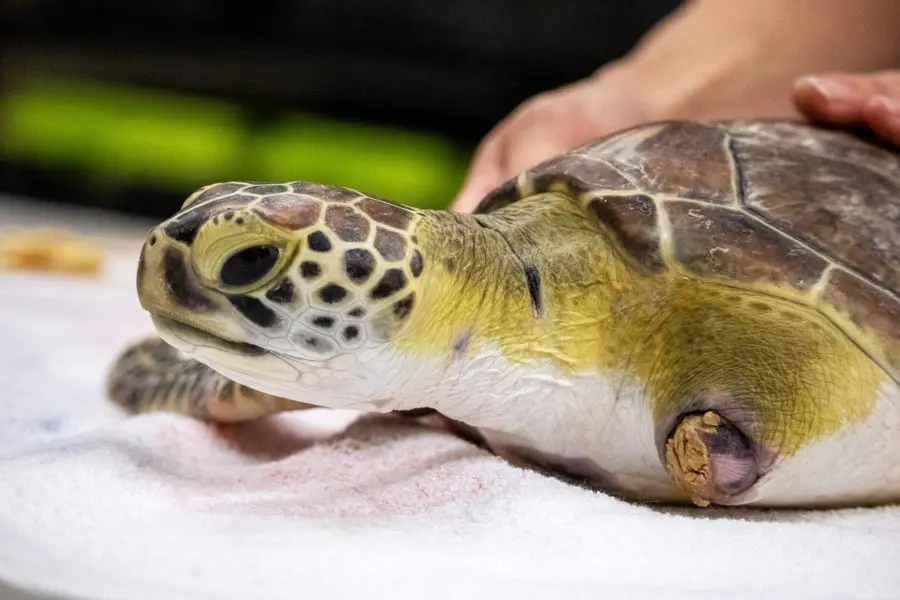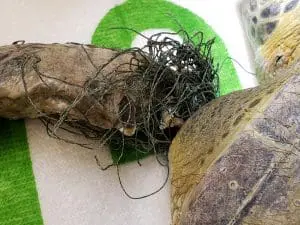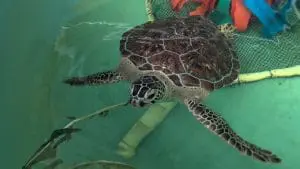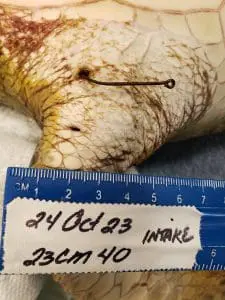

We’re thrilled to share that we’ll be holding a double sea turtle release this Wednesday, December 13! Juvenile green sea turtles Gorp and Peter Pan will be heading home to the ocean after several months of rehabilitation at our Sea Turtle Healing Center for fishing-related injuries.
Hooks, fishing line and other fishing gear can be very harmful to marine life, especially turtles. Please remember to pack your fishing gear before and after use, and place unwanted fishing line in the designated bins at waterfront parks.
Gorp and Peter Pan will be released, rain or shine, at 10 a.m. from Lori Wilson Park in Cocoa Beach. This release is open to the public, and we recommend arriving early as flippers will be in the water at 10 a.m.!
Gorp came to our Healing Center on August 31 after being found in Port Canaveral with fishing line wrapped around their neck, front flippers and back right flipper.
“Fishing line entanglement and ingestion is one of the worst things that a sea turtle or any wild animal can go through,” said Jess Patterson, Sea Turtle Healing Center coordinator.
“It’s painful and it’s a slow death if they can’t get help.”

An intake photo taken of some of Gorp the green sea turtle’s injuries.
The damage done to the left front flipper was so traumatic that the limb had to be amputated. Luckily, sea turtles can do very well in the ocean with only three flippers. Five-pound Gorp has a lot of growing to do as well, and the turtle’s body will learn to compensate more for the missing limb.
Gorp’s back flipper had areas of tissue that had begun to die off after being wrapped in fishing line. Our Healing Center team worked hard to ensure Gorp was able to keep that flipper. A fish skin graft was applied to the area to help it heal – and although Gorp still has some scar tissue on that flipper, the limb is otherwise healthy and usable. Within a week, the necrosis had stopped.
In addition to giving Gorp wound care and antibiotics, our team also monitored Gorp for a few weeks after their arrival to make sure this little turtle hadn’t eaten some fishing line as well.
Our team will remember Gorp as a typical green sea turtle – curious about everything around them. The sea turtle spent a lot of time using our specially made “itchies” or objects for sea turtles to scratch their carapaces, or top shell, on.
Gorp’s name was inspired by the date they arrived at our Healing Center – National Trail Mix Day. GORP is an acronym for “good ol’ raisins and peanuts,” another term for trail mix.

Good luck, Peter Pan!
Green sea turtle Peter Pan was found in Jetty Park, Port Canaveral on October 24 floating and struggling at the water’s surface by a bystander. Thank you to the Sea Turtle Preservation Society and Florida Fish and Wildlife Conservation Commission for netting this turtle and bringing Peter Pan to us for care.
Peter Pan had three hooks in their front flippers, one of which still had a lure on it. The other two were older and rusted fragments, so our Healing Center team could tell that this turtle frequented the pier, probably looking for an easy snack.
Once the hooks were removed, Peter Pan received broad spectrum antibiotics, x-rays to make sure they did not eat any hooks, and frequent cleanings of the sites where the hooks were removed.

One of the three hooks in green sea turtle Peter Pan’s flipper.
Peter Pan lived in a habitat with our residents green sea turtle McNubbins before release. Peter Pan was a very picky eater, but McNubbins worked her “Menturt” (turtle mentor) magic and Peter Pan started eating everything offered. Peter Pan quicky became McNubbins little shadow and was very interested in whatever she was doing.
This sea turtle’s name was inspired by the classic children’s story character.
“Peter Pan was a character who was in an endless battle with a villain named Hook,” Jess said. “I would say this Peter Pan has had plenty of interactions with such a villain in the ocean.”
Brevard Zoo is an independent, not-for-profit organization that receives no recurring government funding for our operating costs. Your generous support enables us to continue to serve our community and continue our vital animal wellness, education and conservation programs.
